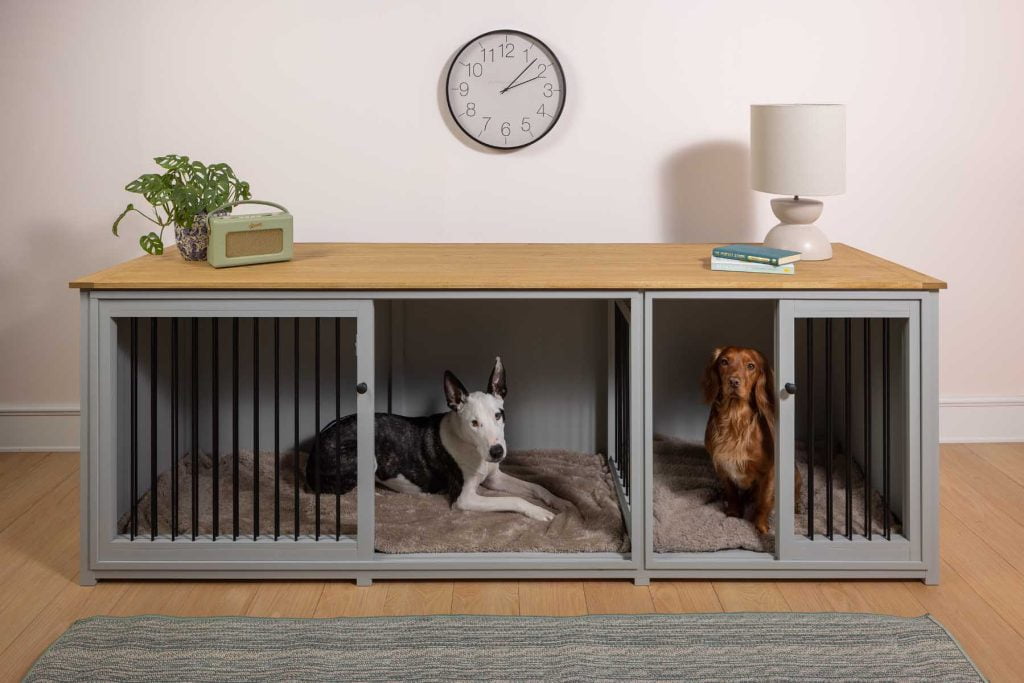Living with more than one dog can be incredibly rewarding, but it also brings unique challenges. Each dog has different needs depending on age, energy levels, and personality. When managed thoughtfully, a multi-dog household can be calm, connected, and enriching for everyone involved.
This article explores how structure, boundaries, and confinement tools like crates and pet furniture can support multi-dog living — and why designing these environments with intention is key.
Understanding the Dynamics of Multi-Dog Homes
Every dog has their own rhythm. Some are more confident, others more reserved. Puppies need longer rest periods. Older dogs may prefer a quieter spot away from energetic play. In a home with multiple dogs, conflict and overstimulation can arise when routines aren’t aligned or personal space is lacking.
This is where structured environments come in. Dogs, like humans, thrive on clear expectations and safe boundaries. Whether you’re managing a puppy and a senior, or introducing a new dog to an existing group, planning your space is crucial.
Setting Boundaries with Confidence, Not Control
One of the simplest and most effective ways to manage behaviour in a multi-dog home is by creating zones. These can be used for feeding, sleeping, playing, or just relaxing. Doors, gates, and crates can all be used to manage these zones without making your home feel like a kennel.
Crate training in particular helps give dogs a safe, designated space they can retreat to when they need rest or calm. It also enables owners to prevent conflict or overstimulation before it happens.
Veterinary nurse Alice Hill, who shares her home with five gundogs, says:
“All of my dogs love their crates. Even the older ones still enjoy getting into the younger dogs’ crates. It’s a safe place, especially for young puppies learning to settle and rest.”
This kind of structure helps dogs feel secure and understand what’s expected of them, reducing stress and behavioural issues.
Why Rest is Essential in Multi-Dog Homes
In homes with dogs of varying ages or energy levels, providing separate rest areas can make a world of difference. Puppies, in particular, require 18 to 20 hours of sleep each day to support development. Older dogs also benefit from downtime away from busier areas of the home.
The Generation Pup study by Dogs Trust found that giving puppies positive early-life experiences, including crate training, significantly reduced the likelihood of developing separation-related behaviours later in life.
Providing a designated rest space is not just about comfort — it’s about supporting a dog’s long-term wellbeing.
Integrating a New Dog into Your Home
Welcoming a new dog is an exciting time, but it also requires careful management to maintain harmony. Whether you’re introducing a puppy or rehoming an adult dog, gradual integration is key.
Crates and baby gates can help you manage space and pace introductions. Feeding in separate zones, creating visual barriers, and ensuring each dog has their own resting space helps avoid tension and gives everyone time to adjust.
The Role of Confinement Tools in Daily Life
Confinement tools like doors, gates, and crates can sound clinical, but when used well, they actually enhance freedom and reduce conflict. They help set gentle boundaries, promote rest, and allow you to manage movement around your home.
Solicitor Dinah Liu, who uses a bespoke crate from The Pet Carpenter, highlights how useful crate training has been for practical safety:
“We’ve paired ‘go to your crate’ with a command. It’s come in useful when we’ve dropped glass on the floor for example. We know our dog will go to his crate and stay there until it’s safe.”
Having that level of communication and structure supports not only safety, but a strong bond between dog and owner.
When Crates Become Furniture (And a Talking Point)
Traditional crates often feel temporary, out of place, or just plain unsightly. That’s why so many multi-dog households are choosing pet furniture that blends with their interiors and meets each dog’s unique needs.
Bespoke furniture, like that created by The Pet Carpenter, can provide multiple crate spaces, additional storage, and even double as islands, sideboards, or media units. It brings a whole new level of harmony, not just for the dogs, but for the home.
“We wanted something that would fit into our home seamlessly that the dogs would love just as much as we did,” said Alice Hill. “Now, all the dogs take turns enjoying their crate space.”
For Grania Benson, her pet furniture piece serves as both a crate for Beau, and a kitchen island, blending seamlessly with her cabinetry, colour matched to perfection.
Encouraging Gift Crate Confidence
At The Pet Carpenter, we call this “gift crate confidence”; helping dogs and owners feel good about confinement as a positive, enriching part of daily life.
The Generation Pup research supports this. It shows that puppies given calm, structured environments with designated safe spaces are less likely to develop stress or anxiety-related behaviours in adulthood.
A beautifully crafted crate can be more than just a training tool. It becomes part of your dog’s routine, your family’s lifestyle, and your home’s aesthetic.
Final Thoughts
Multi-dog homes can be full of joy, energy, and connection, with the right structure in place. Crates, gates, and thoughtfully designed spaces support each dog’s needs while giving owners peace of mind.
Pet furniture isn’t just about looks. It’s about creating a living environment where dogs can thrive, and where their needs don’t conflict with the beauty or function of your home.
When every dog has a space of their own, everyone relaxes a little more. And when that space is something you’re proud to show off, it’s a win for the whole household.
Related Reading & References
Explore bespoke pet furniture solutions in our gallery and Start Your Design Today
